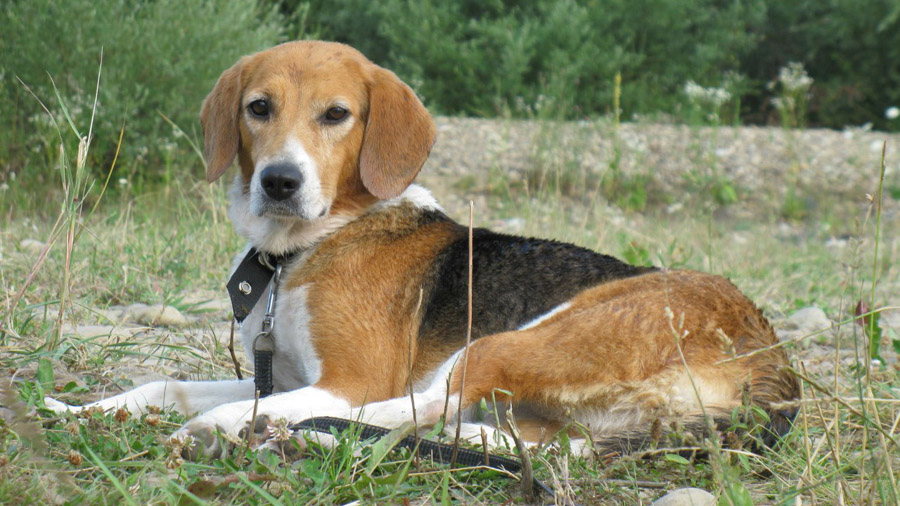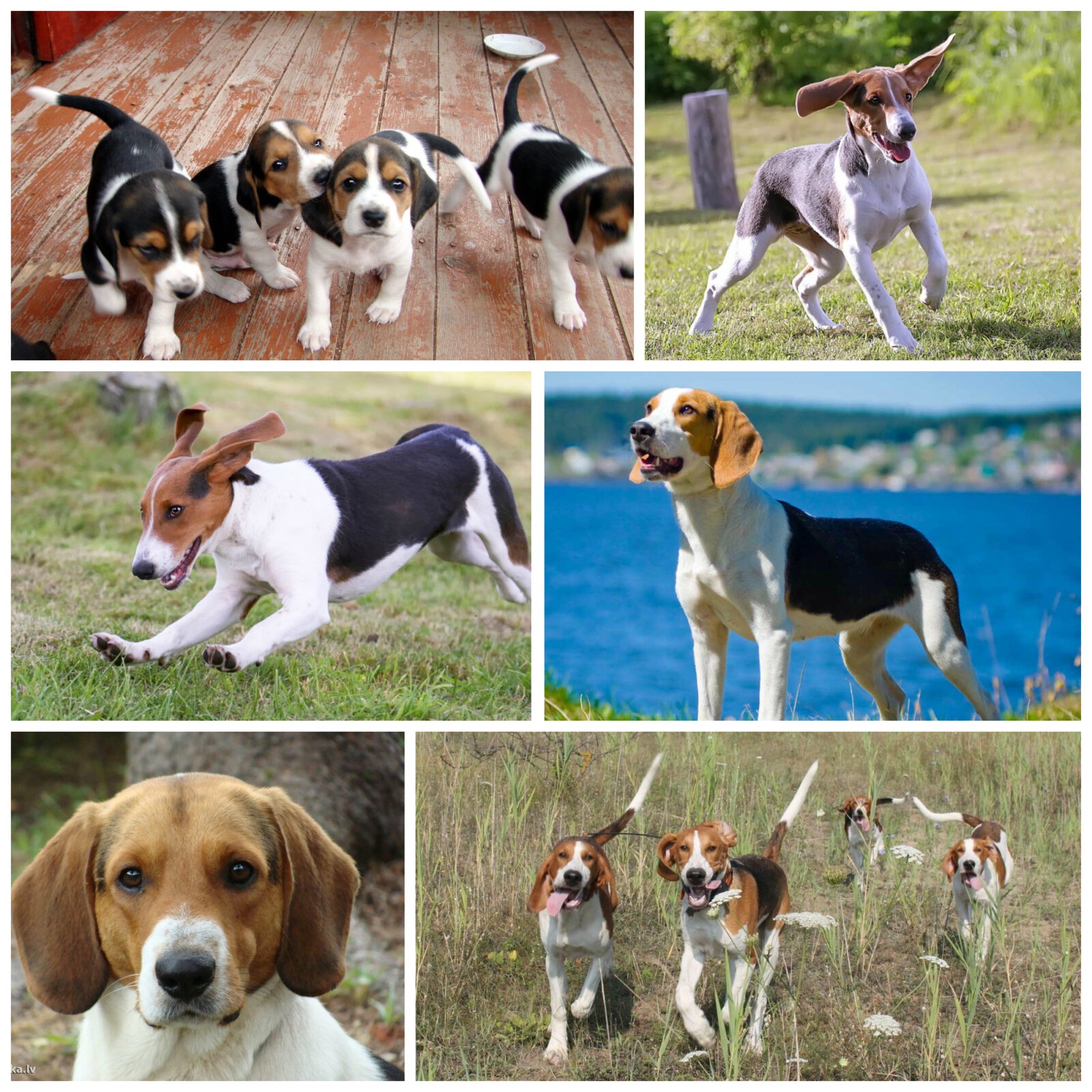
Краткое описание породы Эстонская гончая
О мелодичности и силе голоса эстонской гончей иногда идут споры со стороны охотников. Хотя в плане музыкальности лая она проигрывает некоторым гончим породам (той же русской гончей), эстонская гончая всегда с готовностью, самобытно и звонко возвещает владельца о местонахождении дичи. Чаще всего гончих из Прибалтики привлекают к добыче утки, зайца, лисы (иногда парнокопытных). С полугода эти небольшие, но крепкие и сообразительные собаки способны показывать свои первые результаты во время поимки зверя. Но любят эстонских гончих не только в охотничьих кругах — они также способны играть роль прекрасных и очень послушных домашних любимцев. Эстонцы довольно дружественно относятся к людям, обладают хорошим характером и преданностью. А их габариты (рост до 52 см, вес до 25 кг) и непритязательность в уходе позволяют владельцу содержать собаку даже на небольшой жилплощади. Хотя владельцы-охотники высказываются в пользу проживания гончих поближе к природе.
Эстонские гончие — крепкие, сухого склада собаки. Форма головы у них округлая, надбровные дуги заметно выражены. Переход ото лба к длинной морде плавный. Уши эстонских гончих низкого постава, средней толщины, висячие. Глаза темно-коричневого оттенка, миндалевидные. Прикус ножницеобразный. Шея мускулистая, сухая, подвес отсутствует (вообще, для эстонских гончих не характерны кожные складки). Туловище прямое, с развитой мускулатурой, в области крупа отмечается небольшая покатость. Конечности костистые, очень сильные. Хвост не короче скакательного сустава, широкий в диаметре у основания, узкий к концу. Окрасы эстонских гончих – черно-пегие, буро-пегие и черно-пегие в румянах. Шерсть эстонцев короткая, жесткая, слабо выражен подшерсток.
Основная информация
| Название породы: | Эстонская гончая |
| Страна происхождения: | Эстония |
| Время зарождения породы: | XX век |
| Тип: | не признана |
| Вес: | 10 – 25 кг |
| Рост (высота в холке): | 45 – 52 см |
| Продолжительность жизни: | 10 – 12 лет |
|
Классификация МКФ:
|
не признана |
| Цена щенков: | 100 – 400 $ |
| Самые популярные клички: | список кличек для эстонской гончей |
Оценка характеристик породы Эстонская гончая
| Адаптивность
(определение, означающее, насколько легко собака может приспосабливаться к изменениям в жизни) |
🐶🐶🐶🐶 |
| Уровень линьки
(Уровень и частота выпадения волос у животного) |
🐶🐶🐶 |
| Уровень нежности
(Уровень и количество нежности и ласки, которую собака отдает взамен на внимание к себе) |
🐶🐶🐶 |
| Потребности в упражнениях
(Уровень дневной активности собаки) |
🐶🐶🐶🐶🐶 |
| Социальная потребность
(Необходимое количество контактов собаки с другими животными, а также людьми) |
🐶🐶🐶 |
| Квартирное содержание
(Фактор, определяющий уровень шума и иных неудобств, которые собака может доставлять хозяевам в соотношении размера квартиры к размеру собаки) |
🐶🐶 |
| Груминг
(Количество купаний, расчесываний, а также необходимое количество сеансов профессионального груминга, необходимого собаке) |
🐶🐶 |
| Дружелюбность в незнакомой среде
(Особенности поведения собаки в обществе с незнакомыми людьми или в незнакомой обстановке) |
🐶🐶🐶🐶 |
| Тенденция к лаю
(Склонность к лаю и его частоте и громкости) |
🐶🐶🐶 |
| Вопросы здоровья
(Потенциальный уровень состояния здоровья собаки) |
🐶🐶🐶🐶 |
| Территориальность
(Склонность собаки к защите своего дома, двора или даже автомобиля хозяина) |
🐶🐶🐶🐶🐶 |
| Дружелюбность к котам
(Тенденция к терпимости к кошкам и пониженное проявление охотничьих инстинктов) |
🐶🐶 |
| Интеллект
(Способность собаки к мышлению и решению возникающих трудностей (не стоит путать с обучаемостью!) |
🐶🐶🐶🐶 |
| Воспитание и дрессировка
(Уровень сложности в обучении собаки выполнять определенные действия) |
🐶🐶🐶🐶🐶 |
| Дружелюбность к детям
(Фактор, определяющий насколько собака дружелюбна к детям, любит ли она с ними играть и терпеть некоторые детские шалости) |
🐶🐶🐶 |
| Игровая активность
(Понятие определяется самим его названием, и, как правило, встречается почти у всех собак) |
🐶🐶🐶🐶🐶 |
| Наблюдательность
(Способность собаки определить присутствие чужого на своей территории) |
🐶🐶🐶🐶🐶 |
| Дружелюбность к другим собакам
(Склонность собаки находить общий язык с другими своими сородичами) |
🐶🐶🐶 |
Фото эстонской гончей:

История происхождения
Характер эстонской гончей
При отсутствии пробелов воспитания эстонцы вырастают добрыми, неназойливыми животными, дружелюбными к семье владельца (даже к деткам). К другим животным в доме относятся терпеливо, если с самого появления щенка хозяин позаботится о том, что в кошках, собаках или грызунах собака будет видеть равного себе члена семьи, а не дичь, которую нужно преследовать.
Гончие из Эстонии прекрасно схватывают элементы обучения, редко бывают упрямыми. Неутомимые и сильные физически, они могут гнать зверя на протяжении многих часов. Бывалые охотники хвалят эстонских гончих за прекрасное исполнение работы по преследованию зверя независимо от погодных условий, сложности местности. Будут привлекать эстонскую гончую к охотничьему промыслу или нет, хозяину стоит отдавать себе отчет в том, что это всегда активная, подвижная собака, поэтому постоянное времяпрепровождение в четырех стенах не подойдет для нее.
При неправильном воспитании эстонская гончая может поддаться собственному охотничьему инстинкту, погнавшись за каким-либо животным. При этом недалеко до беды, особенно если неподалеку оживленная автотрасса. Помимо послушания следует с раннего возраста приучать эстонскую гончую к четкому разграничению «свой-чужой». Слишком доверчивая к людям собака может пострадать, взяв, к примеру, угощение от недоброжелателя. Поэтому щенок сызмала должен иметь одного непререкаемого лидера — собственного хозяина.
Содержание и уход
Прекрасно уживаются эти гончие практически везде — в квартире, на свежем воздухе на участках дачных и частных домов (нужны вместительный вольер и утепленная будка), в охотничьих хозяйствах. Они легко переносят практически любые температуры (исключение — сильные морозы, поскольку подшерсток их довольно скудный). Кстати, при содержании в квартире такой собаки в разы отмечается ухудшение чутья при наличии сквозняков, при определении места для сна и отдыха собаки недалеко от кухни. Негативно влияют на чутье разнообразные сильно пахнущие средства — краска, лак, дезодорирующие вещества.
Уход за шубкой эстонских гончих не подразумевает особых сложностей. Достаточно вычесывать их еженедельно (или чаще) щеткой для жесткошерстных собак. Во время весенней и осенней линьки вычесывание следует проводить ежедневно, массируя кожу, удаляя отмершие волоски, частички кожи. Купать эстонских гончих следует по мере загрязнения, но не нужно делать этого в тех случаях, когда шубка собаки достаточно чиста. Хватает порой мытья лап, особенно в тех случаях, когда эстонская гончая – это собака-компаньон, не принимает участия в охоте.
Чистка глаз, ушей, зубов, стрижка когтей – эти процедуры должны войти в привычку у собаки с момента ее появления в доме. Владельцу придется следить за всеми возможными опасными симптомами, говорящими о болезни (скачки температуры тела, рвота, запор, диарея, отказ от принятия пищи и воды). При первом подозрении на болезнь следует обратиться в ветклинику или же вызвать врача на дом. Целесообразно приобрести составляющие для домашней аптечки, ведь иногда помощь должна быть оказана в кратчайшие сроки. О медикаментах следует посоветоваться с ветеринаром, который будет проводить профилактические осмотры собаки (хотя бы раз в полгода-год). На основании осмотра, учитывая возраст, наследственные заболевания животного, ветврач назначит препараты, наиболее подходящие для конкретного питомца.
В качестве корма для эстонской гончей не подойдет пища со стола хозяина. Если владелец располагает достаточным запасом времени, можно отдать предпочтение натуральной пище — мясу и субпродуктам, овощам и злаковым, кисломолочным продуктам (при таком рационе необходим прием витаминных препаратов под контролем ветврача). Проще же выбрать в качестве рациона сбалансированный сухой корм. Правда, в промышленных кормах эконом-класса вреда будет больше, нежели пользы. Поэтому предпочтительнее корма экстра-премиум уровня и холистики. Всегда собака должна иметь доступ к миске с чистой водой (особенно в жару).
Дрессировка и обучение
Эстонская гончая может просто проходить с владельцем азы дрессировки (ОКД — Общий вид дрессировки), узнавая такие команды, как: «Рядом», «Место», «Нельзя», «Гуляй», «Стоять», «Лежать» и другие. После ОКД животное будет послушным и беспроблемным для семьи и окружающих. Опытные заводчики отмечают, что эстонские гончие отлично обучаемы и дисциплинированы. Но прежде чем начать обучение командам, собака должна пройти адаптацию к жизни в новых условиях. С первых же дней щенок эстонской гончей не только знакомится с членами семьи владельца (и другими животными, если таковые имеются), но и привыкает к новым звукам, запахам дома. Даже щенку нельзя позволять спать в хозяйской постели, клянчить пищу, грызть мебель, поскольку во взрослом возрасте отучить собаку от плохого поведения будет значительно сложнее.
Если эстонская гончая приобретается в качестве помощника в охоте, то ее натаской следует также заниматься сразу после того, как щенок привыкнет к новой семье, а между владельцем и собакой установятся доверительные отношения. Приступать же к обучению охотничьему делу требуется, когда животное изучит ряд основных команд. Воспитание собаки-охотника имеет ряд нюансов. К примеру, принятие пищи эстонской гончей должно происходить после поданного владельцем сигнала охотничьего рожка или горна – одного из атрибутов псовой охоты (когда охотник подзывает собаку при помощи своеобразного мелодичного звука). Так впоследствии животному будет проще ассоциировать звук рожка с необходимостью показаться на глаза хозяину. Кроме того, хозяин-охотник с раннего возраста (когда щенку будут сделаны все необходимые прививки) должен брать с собой собаку, когда планирует вылазку на природу. Узнав местность, на которой, возможно, будет происходить поимка дичи, эстонская гончая будет впоследствии ориентироваться лучше и быстрее, когда придет время.
Какая участь бы ни была выбрана владельцем — чтобы его четвероногий друг блестяще исполнял роль подружейной охотничьей собаки или же радовал домашних, такой породе всегда будет требоваться движение. Не скучные короткие прогулки, а полноценные выматывающие тренировки. С успехом эстонские гончие занимаются аджилити, фрисби, сопровождают хозяина во время велосипедных прогулок или пробежек. Хозяин эстонской гончей должен запретить себе поднимать руку или кричать на собаку. Представители такой породы – одни из самых некапризных и исполнительных, поэтому чрезмерный гнев со стороны владельца их ранит, заставляет сомневаться в собственных силах.
Здоровье и болезни
Несколько интересных фактов
- Покупая щенка в питомнике, на руки владелец получает не только очаровательного эстонца в возрасте 2-2,5 месяцев, но и ветеринарный паспорт, где будет зафиксирована кличка животного. Владелец вправе сократить имя, данное собаке при рождении, или же придумать совершенное новое. Собакам, чье призвание — помощь в добыче зверя, дают имена, характеризующие их основные яркие черты. К примеру, собаку, обладающую сильным певучим голосом, можно назвать Свирелью, Арфой, Громом, Хохотом. То животное, которое отличается суровым нравом во время гона добычи, можно наречь Грозой, Вулканом, а слишком быструю гончую — Ветром, Молнией. Редко эстонских гончих называют излишне мягкими кличками. Но выбор, естественно, остается за владельцем.
- Цена щенка может составлять около 5000-30000 рублей. Приобретать малыша лучше в племенных питомниках, где цена, естественно, будет выше предложенной на рынке или в Сети, но у покупателя собаки не будет сомнений в хорошем состоянии здоровья и отсутствии наследственных заболеваний у малыша.
Питомники и заводчики
Материал мы заимствовали с замечательного сайта наших партнеров DOGCATFAN.COM о кошках и собаках, автор dogcatfan
